Twinleaf (
Jeffersonia diphylla) was one of the first plants I bought when I began seriously using native plants in my home landscaping. I wanted something tolerant of dry shade, and that’s what it said on the tag. I was not disappointed. The plant, with its butterfly-like leaves, took hold and slowly expanded its coverage over the years.
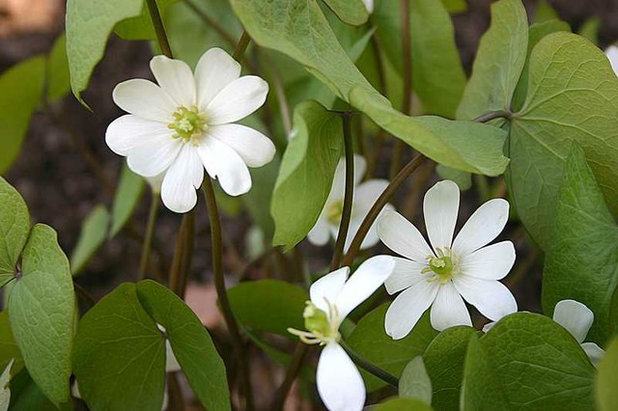
Missouri Botanical Garden
Botanical name: Jeffersonia diphyllaCommon name: Twinleaf
Origin: Native from New York west to southern Minnesota in the north, and south to Tennessee and northern Georgia; prefers moist woodlands, particularly those with limestone-rich soils
Where it will grow: Hardy to -20 degrees Fahrenheit (USDA zones 5 to 7; find your zone)
Water requirement: Grows best in moist to mesic soils; will tolerate periods of drought once established
Light requirement: As a woodland native, twinleaf grows well in partial shade. It is particularly suited to growing under deciduous trees and can tolerate heavier summer shade as long as it gets a good dose of sunlight in the spring. When sited under evergreens, it should be in open shade.
The flower of twinleaf is a striking pure white, appearing for only a brief time in early spring. It looks similar to the flower of bloodroot (
Sanguinaria canadense), which usually blooms a week or two before twinleaf. Unlike many other early-blooming woodland plants, it is not an ephemeral; its foliage persists throughout the summer and into fall, growing stronger and taller with time. This makes it a good plant in a woodland garden, where its foliage can fill in gaps left by other early-spring bloomers that die back as the shade increases.
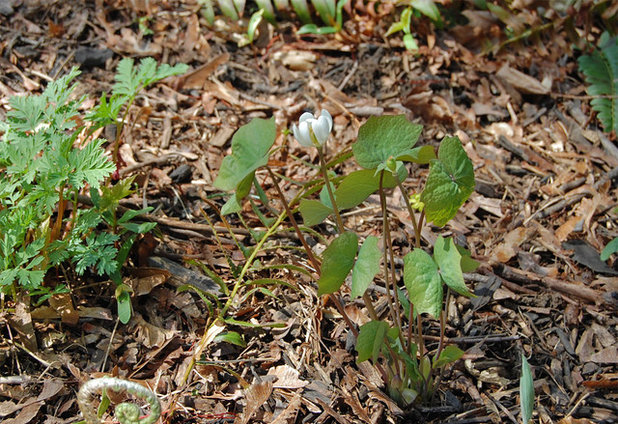 Mature size:
Mature size: At bloom time, in early spring, it is about 8 inches tall. The mature foliage reaches heights of 12 to 18 inches tall. Individual plants are 6 to 12 inches wide.
Benefits and tolerances: Twinleaf prefers neutral to alkaline soils, making it a good candidate for planting near a concrete foundation. It is generally considered deer resistant; however, deer will occasionally browse the foliage. While it’s ideally grown in cool, moist sites, I had good success growing some under a Norway maple in the Boston area, a classic example of dry shade.
Shown: Twinleaf in midbloom at the end of April. It is planted with wild bleeding heart (
Dicentra eximia) and Christmas fern (
Polystichum acrostichoides) under a Norway maple (
Acer platanoides)
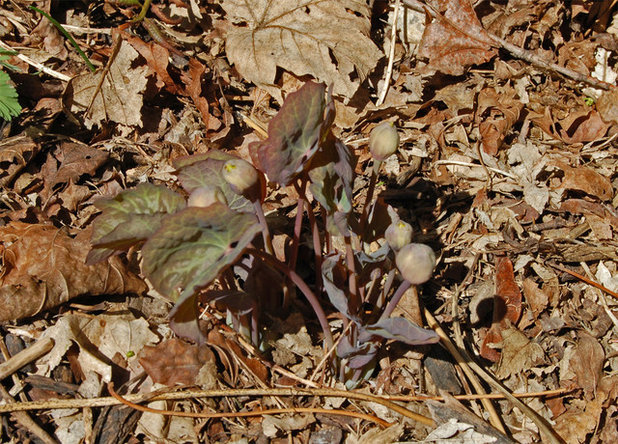 Seasonal interest:
Seasonal interest: The blooming period is early and brief. Pure white flowers, measuring 1 inch to 1½ inches across, consist of eight to nine petals and open up in mid to late April. The flowers are very delicate and are intact for only one to three days; each plant will produce multiple flowers over a one- to two-week period. The distinctive foliage lasts from mid-April to midfall and is of greater interest in the garden.
When to plant: Container plants can be planted from spring to fall. Twinleaf is more commonly available as bare-root plants, which should be planted when dormant, in late fall or very early spring.
Shown: The leaves and flowers sprout at about the same time. This photo was taken in mid-April in the Boston area.
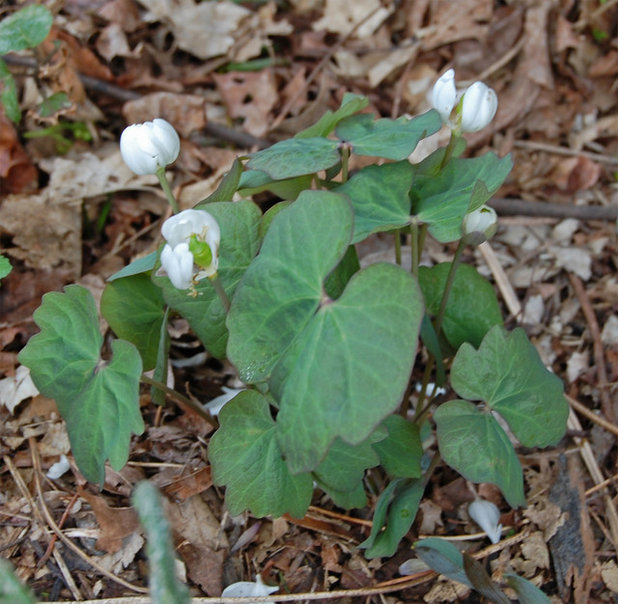 Distinguishing traits.
Distinguishing traits. This plant is most noted for its long-lasting, deep blue-green foliage. Each leaf consists of a pair of identical leaflets borne on a single stem. They are like big green butterflies. The foliage typically lasts from late April to the first killing frost in midfall. The leaves and flowers grow out of the ground on their own stem that comes from an underground stem, or rhizome.
A green, urn-shaped capsule remains after the flower petals drop off. The seeds mature around mid-June, and the capsule pops open to reveal large brown seeds. These spill onto the ground, where many of them are gathered up by ants that are attracted to the oily, nutritious appendages (elaiosomes) on the seed. This is the plant’s mechanism for seed dispersal. After the ants carry the seeds to their nests and feed on the coatings, the seeds are left underground to germinate and start a new plant near the ants’ nesting site.
Shown: The same plant as above, one week later. The closest flower has lost some petals, revealing the seed capsule forming in its center.
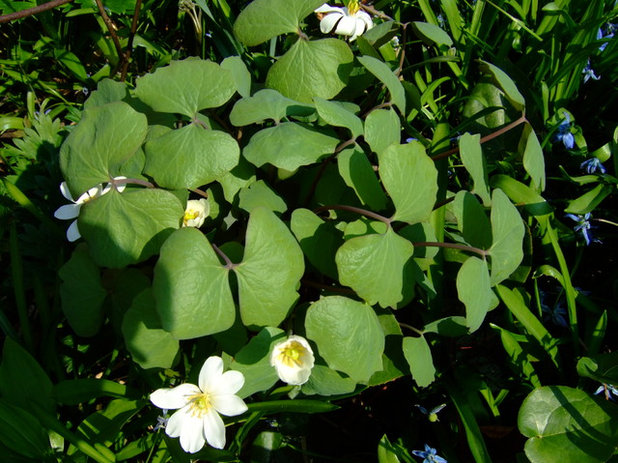 How to use it.
How to use it. Twinleaf is best used as a ground cover in moist, shady deciduous woods. Ecologically it is classified as a late-successional species and is a good choice for a mature woodland that gets minimal disturbance.
Since it prefers alkaline soils, twinleaf is well suited to planting near concrete foundations as well as near lawns, which may be heavily treated with lime. Its shade tolerance also makes it a good candidate for use near structures that do not offer a lot of direct sunlight. Note that it does need some sunlight to be successful, be it reflected light, open shade or lots of light in the spring before the tree canopy grows over.
Other Mid-Atlantic natives that you might find growing with twinleaf include wild ginger (
Asarum canadense), alumroot (
Heuchera americana), Solomon’s seal (
Polygonatum biflorum) and Virginia bluebells (
Mertensia virginica).
Photo by Jdsteakley
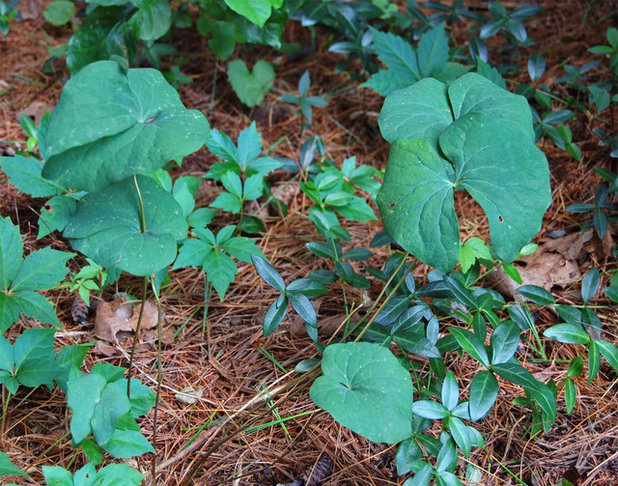 Planting notes.
Planting notes. Twinleaf is not widely available in retail nurseries and is easiest to find as bare-root plants in native-plant nurseries, via online sites or through mail-order nurseries. It can be grown from seed, but it takes some time to get significant results.
Fresh seed germinates as the weather cools. The plant spends the first year growing a root system. Leaves will sprout up in the second spring after planting. Flowering typically occurs three to five years after the initial planting. For me, it is easier to wait for plants to naturally reseed themselves. The plant also spreads slowly and vegetatively by its underground rhizome. In areas with acidic soils, add some garden lime around the plant to bring the pH to near neutral.
Several species of bees and flies that are active in mid to late April pollinate this early-blooming flower. Twinleaf also has an interesting mechanism for self-pollination. The flowers close up each night. When this happens, the petals push the pollen-bearing stamen up against the stigma at the top of the capsule, thus pollinating themselves.
Shown: The plants here are growing in open shade under some white pines (
Pinus strobus) and Eastern redcedar (
Juniperus virginiana). While they’re not growing in ideal conditions, these plants have been holding their own, growing and blooming over the past three years.
More:How to Design a Beautiful Shade Garden
Browse plants native to other regions of the U.S.





